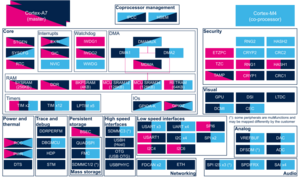Registered User mNo edit summary |
Registered User mNo edit summary |
||
| (3 intermediate revisions by 3 users not shown) | |||
| Line 1: | Line 1: | ||
{{InternalInfo| This article is replaced by [[STM32MP1 internal peripherals assignment table template]] since v5, but it is kept to make possible the reading of anterior versions}} | |||
<onlyinclude> | <onlyinclude> | ||
<div class="toccolours mw-collapsible mw-collapsed"> | |||
''Click on the right to expand the legend...'' | |||
<div class="mw-collapsible-content"> | |||
[[File: STM32MP1IPsOverview.png|link=STM32MP15_peripherals_overview|thumb|STM32MP15 internal peripherals]] | [[File: STM32MP1IPsOverview.png|link=STM32MP15_peripherals_overview|thumb|STM32MP15 internal peripherals]] | ||
| Line 7: | Line 11: | ||
* <span title="system peripheral" style="font-size:21px">✓</span> is used for system peripherals that cannot be unchecked because they are statically connected in the device. | * <span title="system peripheral" style="font-size:21px">✓</span> is used for system peripherals that cannot be unchecked because they are statically connected in the device. | ||
Refer to [[How to assign an internal peripheral to | Refer to [[How to assign an internal peripheral to an execution context]] for more information on how to assign peripherals manually or via [[STM32CubeMX]]. | ||
<br /> | <br /> | ||
The present chapter describes STMicroelectronics recommendations or choice of implementation. Additional possiblities might be described in [[STM32MP15 resources#Reference manuals|STM32MP15 reference manuals]]. | The present chapter describes STMicroelectronics recommendations or choice of implementation. Additional possiblities might be described in [[STM32MP15 resources#Reference manuals|STM32MP15 reference manuals]]. | ||
</div></div> | |||
{| class="st-table" style="text-align: center;" | {| class="st-table" style="text-align: center;" | ||
|- style="background: {{STLightGrey}};" | |- style="background: {{STLightGrey}};" | ||
| Line 18: | Line 22: | ||
! rowspan="2" style="text-align: center; width: 25%;" | '''Comment''' | ! rowspan="2" style="text-align: center; width: 25%;" | '''Comment''' | ||
|- | |- | ||
! style="color: white; text-align: center; background: {{STMediumGrey}}; width: 15%;" | <small>Instance</small> | |||
! style="color: white; text-align: center; background: {{STPink}}; width: 12%;" | <small>Cortex-A7<br />secure<br /> (OP-TEE)</small> | |||
! style="color: white; text-align: center; background: {{STDarkBlue}}; width: 12%;" | <small>Cortex-A7<br />non-secure<br /> (Linux)</small> | |||
! style="color: white; text-align: center; background: {{STLightBlue}}; width: 12%;" | <small>Cortex-M4<br /><br /> (STM32Cube)</small> | |||
|- | |- | ||
</onlyinclude> | </onlyinclude> | ||
Latest revision as of 16:20, 6 July 2023
Click on the right to expand the legend...
Check boxes illustrate the possible peripheral allocations supported by STM32 MPU Embedded Software:
- ☐ means that the peripheral can be assigned (☑) to the given runtime context.
- ⬚ means that the peripheral can be assigned to the given runtime context, but this configuration is not supported in STM32 MPU Embedded Software distribution.
- ✓ is used for system peripherals that cannot be unchecked because they are statically connected in the device.
Refer to How to assign an internal peripheral to an execution context for more information on how to assign peripherals manually or via STM32CubeMX.
The present chapter describes STMicroelectronics recommendations or choice of implementation. Additional possiblities might be described in STM32MP15 reference manuals.
| Domain | Peripheral | Runtime allocation | Comment | |||
|---|---|---|---|---|---|---|
| Instance | Cortex-A7 secure (OP-TEE) |
Cortex-A7 non-secure (Linux) |
Cortex-M4 (STM32Cube) | |||
